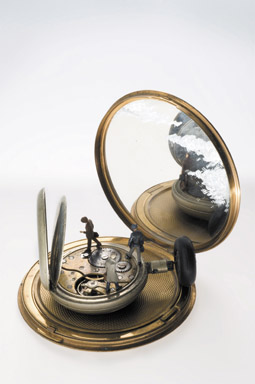an itty-bitty theatre of the absurd
annemarie jonson on the art of kendal murray

Kendal Murray, Game, Aim, Blame, Proclaim
courtesy of the artist
Kendal Murray, Game, Aim, Blame, Proclaim
THE FRENCH ROMANTIC POET OF THE 1870s, ISIDORE DUCASSE, AKA THE COMTE DE LAUTRÉAMONT, HIT ON AN IMAGE OF BEAUTY THAT WOULD LATER BE CHAMPIONED BY ANDRÉ BRETON AND HIS COLLEAGUES AS AN EPIGRAM FOR SURREALISM: THE RANDOM ENCOUNTER OF AN UMBRELLA AND A SEWING MACHINE ON A DISSECTING TABLE. ACCORDING TO BRETON ET AL, THE PROPHETIC DUCASSE HAD NAILED THE SURREALIST SHTICK 50 YEARS AHEAD OF TIME. IN MAX ERNST’S LOOSE PARAPHRASE OF THE SELF-STYLED COUNT, IT’S ALL ABOUT THE COUPLING OF INCOMPATIBLE REALITIES IN AN INAPPROPRIATE PLACE.
Such random encounters and oddball couplings abound in Kendal Murray’s exquisite An Enchanted Life, with its insistently surrealistic undertow. Here, the dissecting table is a vintage facepowder compact, purse, or teapot, diminutive proscenia in which everyday objects and tiny, naturalistic plastic figures collide in complicated dramas of startling illogic. Not for her the pop-kitsch of the melting clock school of surrealism. Murray’s are the whip-smart inversions of causality and torsions of logic of, say, Meret Oppenheim’s alarming fur cup-and-saucer set (Breakfast in fur), or Magritte’s La reproduction interdit, the low-key nightmare in which an anonymous everyman fronts up to a mirror which reflects only the back of his own head.
As did the surrealists’ work, Murray’s Enchanted Life inhabits the terrain of fantasy, dream and the unconscious as it irrupts into conscious life. Many of the 36 sculptures that make up the show mine the rich lode of metaphor and metonymy that, in psychoanalysis, characterises dreamwork, some leavened by offbeat humour. Motifs include water, the sylvan glades of nature, and the deepseated thrum of anxiety played out in the archetypal dreams of falling from heights or appearing unclothed in public. Murray’s scenarios feature objects of perceptual framing or of transition from interior to exterior space—windows, ladders. And in the pieces using vintage powder compacts, the mirrored backdrop is omnipresent, multiplying the hermetic mise en scene of the miniature, a trope of the unconscious, as the outside is likewise reflected in.
In Advance, Romance, Perchance, a man and woman sit with their backs to each other on opposite sides of a bed, his arms folded defiantly. A tall tree with lush foliage sprouts between them from the marital mattress—a rebus, perhaps, for existential disconnection and loss, potently metaphorising what it is to grow apart. In Implore, Ignore, Done For, a relationship is frozen in moment of chaotic meltdown worthy of a feverish Albee. A woman stands with arms akimbo precariously teetering on a towering jumble of chairs, a cleaner in the corner sweeping up the scattered debris surrounding her. The female protagonist looks expectantly to a man with his back to her, standing on a table, leaning out of a window. His escape, if that’s what it is, is thwarted by the mirror/wall that occludes the window and visually loops him back into the chaos, enmeshing him in the domestic maelstrom. In another riff on coupledom, oblivious young lovers embrace on top of a parked car overrun by a luxuriant blanket of grass, as time, for them, telescopes into one crowded hour.
Elsewhere, a high diver launches headfirst into a backward swandive off a precipitously high ladder into a half-filled bathtub. Simultaneously, in what seems to be another temporal dislocation—a flash-forward to the unpretty ending?—cleaning women scrub the tiled bathroom floor. In another watery scene, two boatmen in a tiny craft battle the roiling, treacherous seas of a storm in a compact. A neat play complicates the dream/wakefulness, inside/outside divide: one flings the boat’s wildly outsized anchor right over the compact’s gilded edge, shattering the fourth wall.

Kendal Murray, Chase, Replace, Erase
courtesy of the artist
Kendal Murray, Chase, Replace, Erase
Murray’s Lilliputian tableaux are no less compelling for being short on the vivant. A signature of the show is the surprisingly full sense of subjectivity that animates the inert plastic toys in Murray’s itty-bitty theatre of the absurd. These figures, and the vignettes which they play out, possess the slightly perplexing capacity to touch the viewer, eliciting emotional and psychological investment in the characters’ backstories. It’s oddly hard not to care about the psychodramas of these two-cent toys, or involuntarily project into the scenes the freight of a lifetime of psychic flotsam, improvising mini-narratives for them shot-through with the pulse of personal memory, anxieties and desire.
Some works are not so enigmatic, but still powerful and curiously moving. In Chase, Replace, Erase, three drab-suited briefcase-carrying workers endlessly walk the circumference of a splayed-open gold fobwatch, damned to the Sisyphean grind and anonymity of the salaryman. In Distance, Resistance, Existence, down at heel eastern-European émigrés lugging shabby suitcases stand mesmerised by a shopping trolley set on a verdant circle of grass. They’re cut off from the steely grail by a ring of rubble and rocks. The work here has a cast of political theatre, with its poignant take on the diaspora and swipe at the all-consuming commodity fetishism that shorthands late global capitalism.
Murray’s achievement is enduring in several ways. There’s the sheer beauty of her miniatures and the prodigious dexterity of their construction. Then there’s her creation of multiple parallel universes, each layered over with allusion, and each peopled by human-shaped bits of plastic imbued with unexpectedly complex interior life. Most striking is her adroitness of touch in inflecting everyday scenarios with the sudden, disorienting punch of dreamscape and hallucination, exploiting in the most evocative way the convulsive juxtapositions of the surreal.
Kendal Murray, An Enchanted Life, Arthouse Gallery, Sydney, Sept 16-Nov 13
RealTime issue #82 Dec-Jan 2007 pg.






